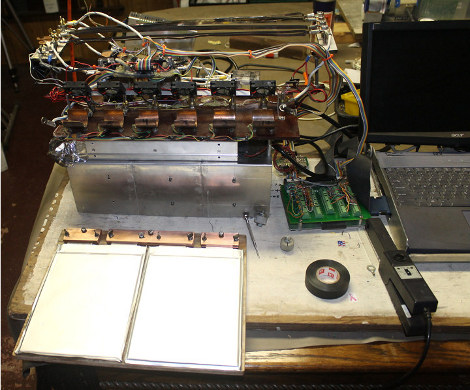
[Mikey] got a real deal on some A123 Pouch Cells. These are large Lithium cells that tolerate 100A discharge and 50A recharge currents, with 20 AH of life off of one charge. He’s been doing a bunch of testing to find out if the cells can go into an expandable battery pack and be made for use with hybrid cars.
We just looked in on a battery tester used for solar power car arrays. This is a similar situation except [Mikey] is focusing on the test data, rather than the apparatus. The link above is a collection of his notes from testing. Start reading at the bottom of the page up to get the chronology right. He starts to zero in on the most efficient charging methods. Immediately he’s hit with a big need for cooling as the cells take no time to pass 100 degree Fahrenheit. He continues testing with heat sink and fan, and even brings a thermal imaging camera to help with the design.
[Thanks Chris]















This is cool, but be on the lookout, looks like there’s some bad cells in the wild.
http://detroit.cbslocal.com/2012/03/26/a123-recalling-55m-in-ev-batteries-made-in-livonia/
Good catch, Razor! That could certainly explain why they were on the Chinese market at a reduced price. Wouldn’t put it past them to try and make a quick buck off something that is supposed to be recalled and destroyed.
No guarantee they will actually fail. Even a few faulty batteries in a production batch are enough to trigger a full recall. A cell of this size failing, especially built into a dense pack with others, is downright scary.
I’d suggest Mikey calls A123 with any information printed on the batteries to see if they’re in the affected batches. It’s worth knowing, even if intends to proceed regardless. He seems willing to take a gamble, having ordered them discounted from China, and trying the two visibly damaged cells. Whatever happens, I wish him success and no fires!
And poor A123. They were already having financial difficulties.
Aren’t the A123 cells supposed to be iron phosphate cells, so they can tolerate heat rather well. I’ve seen people actually heat them up to get more power out.
“at prices that make this an economical alternative to using NIMH.”
Li-ion is never an economical alternative to NiMH where weight is not at premium, because they last far fewer cycles and a much shorter time. A well tended NiMH battery lasts for decades, whereas the lithium will degrade to half in 5-6 years anyways.
Please provide data to back up your statement of “A well tended NiMH battery lasts for decades”.
http://www.dailytech.com/End+of+Life+Approaching+for+Many+Prius+Battery+Packs/article13837.htm
Nothing like a real life example.
I would consider 10 years a successful battery design.
I was the one that put together the buy of cells that Mike has in his hands and based on his (and others’) testing, we’ve been pleased with the cells so far.
The ones he has in the test rig right now are ones we thought were the worst of the bunch. Well, under a 103amp load the “worst” cells seem to be holding up just fine: Very little voltage sag and good capacity.
At the time we ordered over 500 cells and at under $28 per cell delivered, it’s been a good deal. We plan to buy many more.
My goal is to get these into the hands as many people as possible. So feel free to contact me if you are interested in some. — Eric Powers